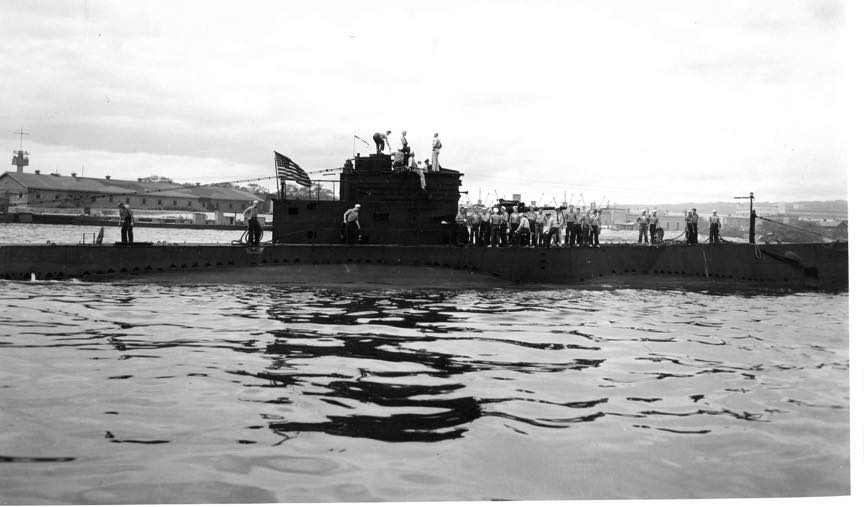
S-41
(SS-146: dp. 854 (surf.), 1,062 (subm.); 1. 219'3"; b. 20'8"; dr. 15'11" (mean), s. 14.5 k. (surf.), 11 k.(subm.); cpl. 42; a. 1 4", 4 21" tt.; cl. S-1)
S-41 (SS-146) was laid down on 17 April 1919 by the Bethlehem Shipbuilding Corp., San Francisco Calif.; launched on 21 February 1921; sponsored by Mrs. John F. Conners, and commissioned on 15 January 1924, Lt. A. H. Donahue in command.
Through the summer of 1924, S-41 operated out of San Francisco, completing her trials and conducting exercises. On 17 September, she departed the west coast with her division, Submarine Division 17, and headed for the Philippines. Arriving at Manila on 5 November, she joined the Asiatic Fleet and, through the winter of 1925, engaged in exercises with surface and submarine units in Philippine waters. In May, she departed Manila for Tsingtao, whence she conducted operations, with her division, off the China coast into September. She then returned to the Philippines and resumed type exercises, patrols, and joint Army-Navy exercises in the Manila Bay-Subic Bay area.
For the next fifteen years, S-41's schedule, and that of her division, remained basically the same; summer months were spent in Chinese waters, winters in the Philippines. The S-boats, primarily engaged in operations as a division during that period, occasionally interrupted their schedule and operated independently on special missions.
In January 1932, after Japanese forces attacked Shanghai, S-41 was ordered to assist in the evacuation of American nationals from the area.
As the decade progressed, Japanese actions in China became increasingly hostile, and S-boat schedules became more varied. Operations and patrols from China and the Philippines were extended to include, by the spring of 1938, the East Indies.
In 1940, S-41's China deployment was shortened to two months. At the end of June, she returned to the Philippines, where she conducted familiarization cruises into 1941. That year was spent at Cavite and Olongapo for overhauls; in the South China Sea for fleet exercises; and in the waters off Luzon on patrol.
On 8 December, S-41 was in Manila Bay. After hearing of Japan's attack on Pearl Harbor, she patrolled off Looc Bay, Tablas Island, in an attempt to impede the Japanese offensive. But the Japanese thrust continued.
S-41 returned briefly to Manila for replenishment but departed again on the 24th. Into the new year, 1942, she patrolled off the Lingayen area. On 4 January, she retired from Luzon and moved south toward the Netherlands East Indies. By the 12th, she was off Tarakan; by the 15th, Balikpapan; and by the 25th, after patrolling Makassar Strait, she was at Soerabaja. On 4 February, she departed that north Java base and returned to Makassar Strait. Thirteen days later, she torpedoed a Japanese transport off Cape Mangkalihat and was credited with a kill by the American-British-Dutch-Australian Naval Command.
On 10 March, she concluded her patrol at Fremantle The Netherlands East Indies had fallen.
Throughout the patrol, S-41's gyro compass had given continuous trouble, and her periscope had proven faulty. Repairs were made at Fremantle and at Brisbane; and, on 9 May, she departed the latter port for the Solomons. Encountering poor weather during the patrol, she operated in the Shortland and Treasury Islands through the end of the month and returned to Brisbane on 6 June.
On 22 July, she headed out of Moreton Bay, returned for emergency repairs; and, on 7 August, got underway for the New Britain-New Ireland area. She fired on several enemy ships, including a submarine with probable damage, and her patrol was noted for its "absence of serious material failures"—an achievement unique in boats of her class at that time.
At Brisbane from 2 September until the 21st, she got underway for Hawaii on the latter date and, after patrolling in the Ellice Islands, arrived at Pearl Harbor on 13 October. On the 29th, she put into San Diego and the next day began an extensive overhaul which lasted into April of 1943. On the 23d of that month she departed southern California for the Aleutian Islands.
Arriving at Dutch Harbor on 11 May, S-41 departed four days later and took up patrol duties off Paramushiro, Kuril Islands, on the 21st. On the 27th, she scored a probable kill on a four-masted fishing schooner; and, in the pre-dawn darkness of the 31st, she torpedoed a cargoman in a night surface attack. From the violent internal explosion and fires which followed the initial torpedoing, the victim was presumed to have been carrying high explosives or light, volatile liquids.
On 15 June, S-41 returned to Dutch Harbor. Thirteen days later, she got underway for Attu, whence she departed for the Kurils on 3 July. Fog, heavy seas, sampans, fishing nets, and the erratic performance of torpedoes hindered her movements and impaired her
hunting during that 33-day patrol and during her final patrol, again off Paramushiro, in late August and early September.
With the onset of winter, S-41 was reassigned to training duty; and, after an overhaul, she commenced those operations out of Pearl Harbor. She returned to San Diego for inactivation in December 1944, and she was decommissioned on 13 February 1945. Her name was struck from the Navy list on 25 February 1946 and, in November of that year, her hulk was sold, for scrapping, to the National Metal and Steel Corp., Terminal Island, Calif.
S-41 earned four battle stars during World War II.
